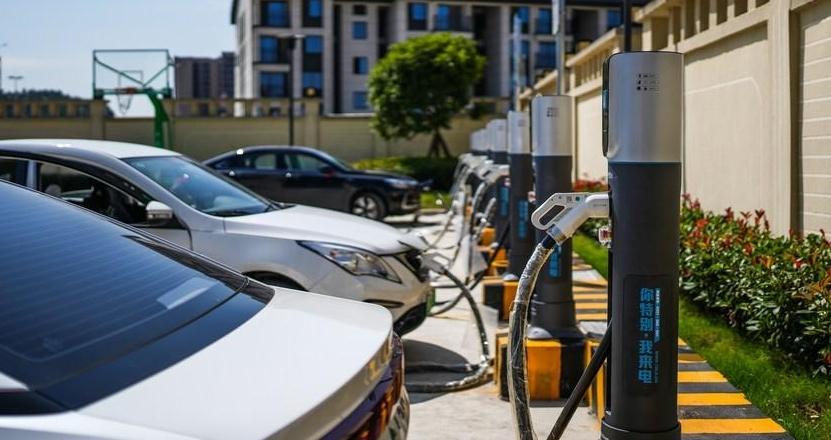Electric vehicles on fast track in rural China
Xinhua, November 30, 2023 Adjust font size:
After nearly a decade of using his petrol car, Zhang Fengxiang, who hails from a small town in the mountainous Guizhou Province in southwest China, opted to switch to an electric vehicle earlier this year.
"With discount, electric car is now a good bargain," he said, adding that roads in rural areas have significantly improved, and charging stations are available everywhere.
Priced at 221,900 yuan (about 31,021 U.S. dollars), the new car is of the domestic brand Changan. Benefiting from a store discount and a government subsidy of 22,000 yuan, around 10 percent of the original price, Zhang ended up paying only 177,900 yuan.
The closest charging station is less than a kilometer away from his home. "After a full charge I can drive up to 700 kilometers," he said. "I just need to charge once every two weeks. Besides, the new car is environmentally friendly."

This photo taken on Oct. 17, 2023 shows new energy vehicles being charged at a charging station in Gujiao Township of Bouyei-Miao Autonomous Prefecture of Qiannan, southwest China's Guizhou Province. (Xinhua/Tao Liang)
In recent years, due to collaborative efforts between local governments and automobile enterprises, new energy vehicles (NEVs) have become accessible to a broader population in China's rural areas.
In Guizhou, where Zhang lives, the accessibility of charging facilities was once a major concern for villagers, making them hesitant to adopt NEVs. As of Sept. 27, with the installation of three charging piles in Yungui Town in Bijie City, all 1,145 towns in the province now boast charging infrastructure.
Guizhou, together with the provinces of Guangdong, Hainan, Yunnan and the Guangxi Zhuang Autonomous Region, achieved comprehensive coverage of all towns with a network of nearly 100,000 electric vehicle charging piles. This has reduced the average charging service distance to approximately 20 kilometers in the rural area.
China introduced several measures to unleash the domestic consumption potential in the NEV sector earlier this year.
The country extended its preferential purchase tax policy for NEVs to the end of 2027 and released a guideline to support people living in rural areas to purchase and use NEVs, focusing on boosting the construction of charging infrastructures. Official figures show that as of May this year, China had installed more than 6.35 million charging piles nationwide.

New energy vehicles run in the zero-carbon demonstration zone in Boao, south China's Hainan Province, March 28, 2023. (Xinhua/Wang Jingqiang)
By the end of September, China had 18.21 million registered NEVs, according to the Ministry of Public Security. More than 5.19 million NEVs had been registered during the first three quarters of this year, up 40 percent from the same period last year, accounting for 28.6 percent of all new automobile registrations.
Zhejiang Province in east China boasts more than 1.65 million NEVs, including over 350,000 units in the rural areas.
The province has almost completed building an NEV charging service network, in which vehicle owners can find a charging pole in the rural area within an average driving distance of five kilometers, three kilometers on the outskirts and one kilometer in the urban area. It aims to further improve the network so that by 2025, drivers can find a charging station within five minutes and 30 minutes of driving in urban and rural areas, respectively.
Even on the Qinghai-Tibet Plateau, NEVs are becoming increasingly prevalent. The vibrant streets of Lhasa, the regional capital of Xizang Autonomous Region, teem with new energy buses, taxis and private cars, effortlessly navigating against the backdrop of breathtaking snow-capped mountains and the majestic Potala Palace.
In the plateau, where the performance of fuel vehicles is significantly impacted by the low-oxygen environment, NEVs have emerged as an appealing and practical alternative. Their lower costs, driven by more affordable electricity due to abundant solar power, make them a compelling choice.

Workers operate at a production line of the new energy vehicle AVATR at a workshop of Chang'an Auto in Jiangbei District, southwest China's Chongqing Municipality, July 20, 2023. (Xinhua/Tang Yi)
Espying the immense potential of the market, an increasing number of carmakers are jumping on the bandwagon to seize a share.
Chinese auto company Zeekr has built charging stations in Xizang, including one in Tashizom, the nearest administrative township to Mount Qomolangma in China.
Back in 2021, Tesla announced that a supercharging network along the highway linking Xizang with its neighboring Yunnan Province was officially completed. Starting from Yunnan's Kunming and traversing through Dali, Lijiang, Lhasa and other popular tourist cities, a total of 14 supercharging stations and one destination charging station have been built along the route.
For Zhou Xun, owner of a homestay in the picturesque Jingshan Town in Zhejiang, improved charging facilities mean more tourists resulting in more income.
"In recent years more tourists choose to travel by car," he told Xinhua. "Many of them would call us before making a reservation to ask if we are close to charging stations."
"So, better infrastructure is really good for the development of rural tourism, and therefore adds impetus to rural revitalization," Zhou said.

